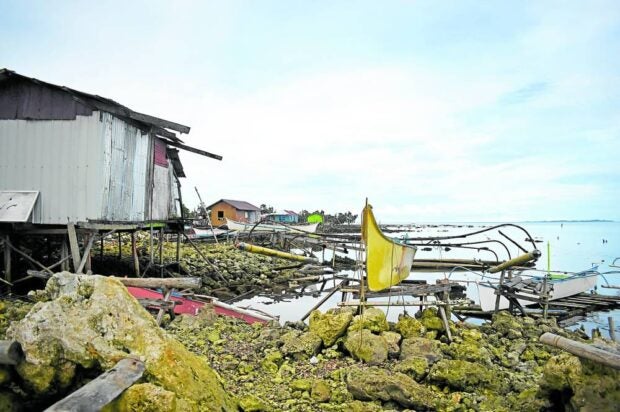Siargao no paradise for informal settlers

SEA LATRINE | This shanty, one among many makeshift houses built along the coastal village of Punta Kawit in Dapa town on Siargao Island, has no proper toilet. Human and household waste go directly into the sea. (Photo by JANE BAUTISTA / Philippine Daily Inquirer)
DAPA, Surigao del Norte, Philippines — Many tourists, Filipino and foreign alike, have found paradise on this teardrop-shaped island of Siargao that boasts white sand beaches and big waves perfect for surfing.
Even the hourlong, 30-kilometer ride from Sayak Airport in Del Carmen town to the beach resorts of General Luna is an experience in itself, offering picturesque views of lush green forests and the palm trees lining the Siargao Circumferential Road.
But away from the scenic spots of this surfing capital lies a less than picture-perfect reality — hundreds of informal settlers who have built shelters in coastal parts of Siargao, despite its status as a protected landscape and seascape. Along with tourists, these villagers now contribute to pollution on the island and threaten its seemingly untouched waters.
Open dump
Thea Petallar, 21, rebuilt a makeshift home in Barangay Punta Kawit, in this town, a 10-minute walk from the main road, after her house was washed away by Typhoon Odette (international name: Rai) in 2021.
“We have nowhere else to relocate where we are safe. We can only build our house here,” Petallar, the mother of an 8-month-old baby, said in an interview.
The family’s primary source of livelihood is collecting and selling five-finger conch shells, leaving them no choice but to settle by the coast.
What passes for a toilet inside Petallar’s humble residence is “where the wood of the house would not break,” and all waste would go directly to the sea.
When the wind isn’t strong, a foul smell lingers in the air, Petallar said.
On the way to the beaches, visitors may notice the rotten-egg stink, not unlike the odor wafting from the island’s sewage treatment plant where wastewater from septic tanks gets processed.
Dapa Mayor Elizabeth Matugas said she was fully aware that the area was polluted because of shanties being built in coastal areas.
She said she had asked the Department of Environment and Natural Resources (DENR) in the previous administration to relocate the informal settlers but her request was “immediately denied” by a former local official because the island is classified as a protected area.
“I argued with the Protected Area Superintendent at that time telling him which is more important—the lives of the people or the life of the birds?” Matugas said in a text message.
Mayor Alfredo Coro II of Del Carmen, on the other hand, appealed to the DENR to let the municipal government use some spaces belonging to the national government as potential resettlement sites.
“They need an appropriate place to live where they can live decently and with dignity, and the DENR can contribute much to that effort,” he said.
Coro underscored that the issue was not only about illegal settlements but the risk of living in a coastal zone.
“Since we are in a typhoon belt, the potential risk of loss of life is higher. That’s why we want to relocate them to a safe space,” he said.
Fecal coliform
Environment Undersecretary Jonas Leones, during the launch of the agency’s Project Transform in Siargao on June 23, disclosed that based on DENR’s water quality monitoring, many communities in Dapa were found to be contaminated with fecal coliform, or bacteria originating from the feces of humans and other animals.
He said Project Transform, designed to help local governments in implementing programs that would create resilient and sustainable communities, could help address the problem of informal settlements through an inventory of public lands.
“Although Siargao is a protected area, there are so many titled lands here, so we will be revisiting those policies and perhaps through Project Transform, we can provide assistance,” Leones said.
In the meantime, while the government is looking for a suitable place to relocate the communities, temporary sanitation facilities should be provided to them, the DENR official said, citing similar projects in Baseco, Manila, and around Manila Bay.
“We can undertake installing a temporary sanitation facility to improve sanitation and at the same time improve water quality in the area,” Leones said.
READ MORE:
Planning to go to Cebu City? Here’s what you need…
Disclaimer: The comments uploaded on this site do not necessarily represent or reflect the views of management and owner of Cebudailynews. We reserve the right to exclude comments that we deem to be inconsistent with our editorial standards.
